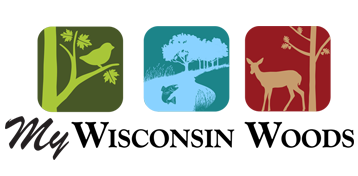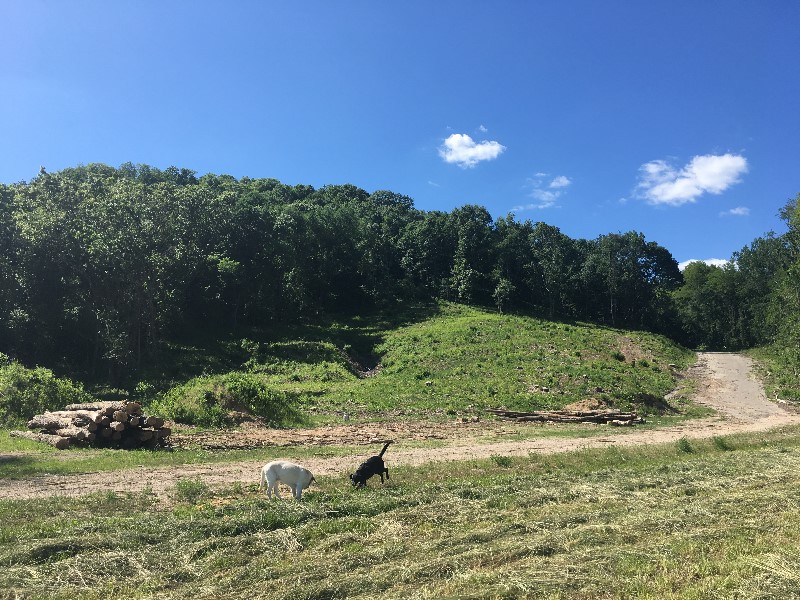
It Takes a Village to Care for Land
“This is a family recreational property, but it is highly degraded. It’s for the benefit of wildlife and we want to witness it, but before we can do that, we have to realign the property with its natural history. We’re well on our way to accomplishing that goal.” – Phil Jennings, Richland County landowner
Detroit – Problem and Opportunity
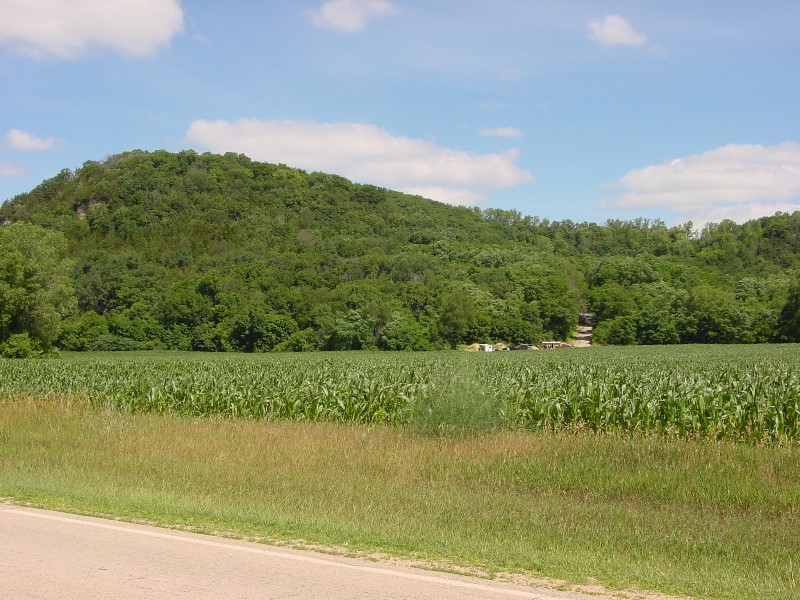
“I call this section of the property, ‘Detroit.’” Phil Jennings smirks. He is serious in comparing his land to the down-on-its-luck city, but Phil has not given up. “At some point, we had to come to terms with ‘Detroit.’ Chainsaws helped.”
Phil’s “Detroit” is a 5-acre stand of black locust, an invasive tree in Wisconsin. While the tree species has redeeming value as durable fence posts, flooring, and exceptional firewood, it can spread quickly to the exclusion of almost everything else. Black locust derives its ecological advantage by releasing chemicals into the soil that inhibit the growth of other plants – little grows under a stand of locust. It reproduces by seeds, but most often spreads by sending out runners underground and popping up nearby. What looks like dozens of individual trees can be one sprawling problem. But not for Phil who is both an optimist and a problem solver.
Phil is an interesting guy. He’s a retired military pilot who is still an active professional pilot, so he’s inclined to make decisive decisions quickly. A lawyer by training, he tends to study things – really carefully. As a real estate developer, he seeks opportunities that are frequently overlooked by others. All of those skills have been brought to bear on the restoration and rehabilitation of his land.
A walk in the woods with Phil can feel like a matter of life or death. And, in a way, it is. In 2016, Phil directed the removal of hundreds of cedar trees from the south-facing bluff prairie. Earlier this year, Phil decisively had the black locust harvested and sold so native species could thrive again. The cedars and black locust were the biggest wounds on the property and he referred to his management of these specific problem areas as “tree-iage.”
Quercus Land Stewardship, Inc., has cut the cedars and is now leading the rehabilitation of the land through controlled burns and nurturing the re-growth of the native species through comprehensive invasive species control efforts.
John Beatty and Mark Schmid of Midwest Black Locust, Inc., have completed the first year of a two-year effort to harvest the black locust trees. “Our plan is to follow-up with treatment of re-sprouts and seedlings and plant a diverse array of native prairie species in place of the black locust,” says Phil. “After all, triage is only the first step. Treatment is the second step – and I’ve learned that cutting down trees is just an intermediate step in the process. The real challenge is rehabilitation, the third step – that’s where the long-term benefits are derived. With a little more rehab, ’Detroit’ will be back on its feet and thriving again with natural prairie grasses and native wildflowers.”
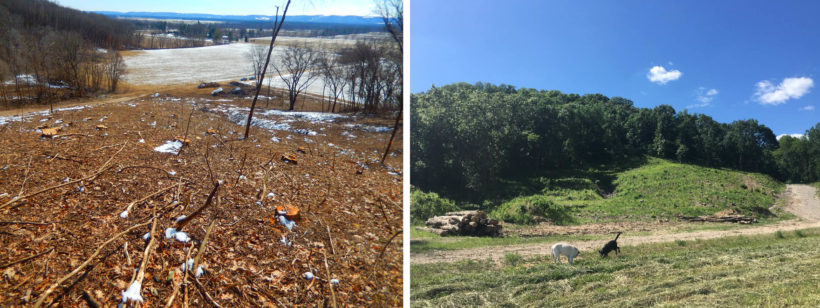
“It Takes A Village”
In 2003, Phil purchased his 35 acres in the bluffs of the Wisconsin River valley in southern Richland County. He had an objective common among urbanites, “I bought this land as a learning and growing experience. I wanted a site for a country home that was both private and close to Madison.” Even though Phil’s life changed significantly after the purchase, these reasons were only underscored. “Along the way I got married and, thankfully, Nicole shares my enthusiasm for this endeavor – she shares my vision for a private setting, that is beautiful, serene, diverse, and a place for us to hike with our happy Labrador retrievers, Tucker and Kostas.” Beyond that, he hadn’t given it much thought. Time passed with little movement and in 2010 Phil got a piece of mail from My Wisconsin Woods with an offer that struck Phil as very appealing. If Phil returned the postcard, a fellow Richland County woodland owner – who was referred to as a ‘Woodland Advocate’ – with land care experience would walk Phil’s property with him. If desired, the peer could connect him to the local county forester.
Phil was ready for a nudge, “Curiously, the term ‘Woodland Advocate’ resonated with me because it sounded like a lawyer for the trees which reminded me of my experience in law school working as a lawyer for prisoners who needed a post-conviction advocate – I needed someone to advocate for the features of this property. I had a sense that there were more problems on this site than I could fully appreciate.”
The Woodland Advocate was Doug Duren. Doug and his siblings own and manage their 400-acre family farm in northern Richland County. The Duren land has been in the family for generations, but more impressively, their family values of accountability and responsibility to “do right by the land” have also held fast. To a landowner like Phil who admits, “It was just a bunch of trees to me,” Doug is every bit an expert landowner, with a lot to offer. In retrospect, Phil readily acknowledges that Doug provided a safe haven for Phil’s inexperience and vulnerabilities. They hit it off, identified some options, and soon involved the professional opinion of the Richland County Forester, Mike Finlay.
Mike is a forester with the Wisconsin Department of Natural Resources. He epitomizes the 21st-century forester, not only capable of seeing the “forest through the trees” but capable of not seeing trees at all. “I need to be an open-minded forester. Landowners have different starting points and a variety of needs.” Success for Mike is a landowner inspired to take any positive action. By Mike’s measure, Phil and his property are a success.
Phil has a typical Southwest Wisconsin property: flattish fields for agriculture, north- and east-facing slopes covered with quality timber, and south- and west-facing slopes, perfectly dry for prairie and savanna. Like a father evaluating his children, Phil sees the property’s nooks and crannies as unique – not better or worse, just different and appreciated. And yet, no matter the differences, all can be an expression of one’s values. Phil is no exception among landowners in feeling that wildlife diversity and abundance are important elements.
On the walk with Phil and Doug more than five years ago, Mike identified prairie and savanna wildflowers choking under eastern red cedars. He provided a sense of the land’s history, pointing out the broad, sweeping arms of old, open-grown bur oaks, trammeled by young, invading trees and understory. He assessed the health risk for vigorous oaks and maples in the presence of unhealthy ones. Phil’s previous diagnosis was upended, “There were trees I had already passed judgment on, and couldn’t tell you why. Now, I can spot an oak tree from a mile away and bur oaks are among my favorites.”
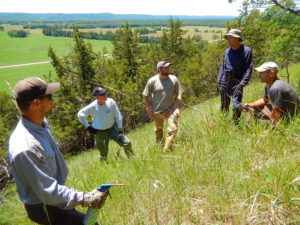
Mike saw many possible courses of action: removing cedars and competing trees to release prairie and bur oaks, thinning out unhealthy trees in otherwise healthy stands, and triaging the worst invasive species to stem their spread. Mike also introduced Phil to Bill Kiser, a wildlife biologist with the US Fish and Wildlife Service (USFWS) with a particular expertise in the rehabilitation of prairies. Bill’s work supports the unique role prairies play in Southern Wisconsin’s natural history and in providing for pollinators. Phil appreciated Bill’s affirmation, “My rehabilitation efforts are a function of Mike and Bill’s creative ideas. I didn’t know these were the things to do, but with their collaboration, we have formulated a treatment and rehabilitation plan that has set us on a very clear and compelling course.”
Bill not only agreed with Mike’s conclusions but offered financial cost-share to hire a contractor for management through the USFWS’s Partners for Fish and Wildlife Program. In addition, Mike utilized the Wisconsin Forest Landowner Grant Program (WFLGP) to get all the ideas on paper and support work on-the-ground. Both of these programs required Phil to have significant “skin in the game,” requiring a match of time, money, or both. Phil’s business sense helped him zero in on the rationale behind these targeted programs. “I get it. Cost-share is an efficient way to bring dollars to bear on significant problems, to stimulate action to solve those problems, and create accountability on the part of the landowner.”
Through a request for proposals, Phil selected Jim Elleson of Quercus Land Stewardship Services, LLC, of Black Earth, Wisconsin. “Through this process, Jim and I, and his Project Manager, Brittany Pierpoint, have become good friends and trusted partners. They have undertaken the most daunting challenges on this site – most notably, removing hundreds of mature cedar trees from the steep, snow-covered bluff prairie with no injuries. It is a testament to Jim’s rigorous safety culture and inspires confidence in both the process and the outcome.”
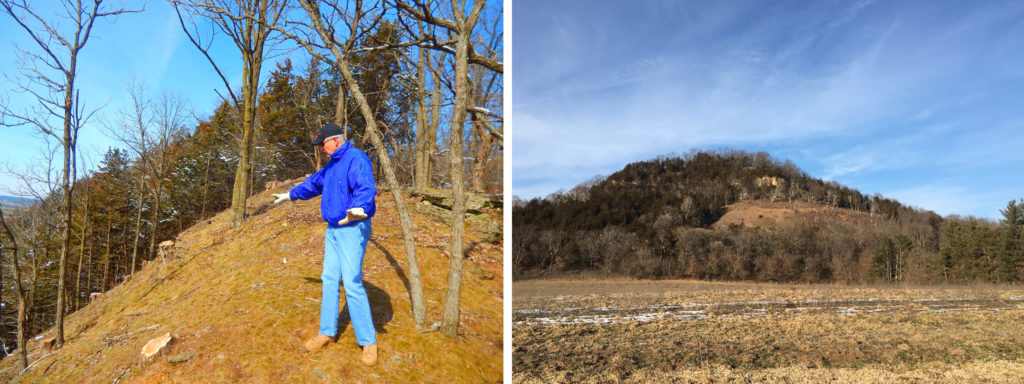
Beyond the native grasses and natural wildflowers which are quickly regenerating, it has also been a matter of life and limb for the young oaks. Mike points to a young tree, “We put ribbons around these oaks when Doug and I walked the land three years ago. We’re ‘daylighting’ them because young oaks will die in the shade of other trees.” Phil refers to these saplings as “the JV Team Oaks” and “the trees of the future.” He’s been happy with the progress that has occurred with almost military precision and an abiding sense of urgency, “Quercus and Midwest Black Locust have put in nearly 1,800 hours between the cedar removal and black locust harvesting.”
Unexpectedly, the personal and professional relationships have enhanced the intrigue of the project and Phil is very pleased with where he finds himself today. “It’s hard – actually, really hard – not to feel good about turning the hands of time back on a degraded site, reinvigorating native prairie plants that serve an array of wildlife, and giving the native oaks a renewed opportunity for longevity. To rehabilitate a highly degraded site with an excellent team of environmentally-conscious professionals is both humbling and a distinct pleasure.”

When Phil first started developing relationships within the natural resources community beginning in 2010 he was struck by how deferential everyone was to him. Phil remembers, “They wanted to serve my needs, but I didn’t know what my needs were, let alone who was going to meet my needs, or how to accomplish what I didn’t understand.” Phil recalls a little resentment with the process, “I had to play quarterback and didn’t know how to – it wasn’t a question of leadership ability, it was a question of industry insights and knowledge of ecology. I had a growing sense that something needed to be done, but I didn’t have any sense of the critical path for achieving an outcome that was unknown to me.” It is one of the issues My Wisconsin Woods has attempted to address by connecting to the many and varied natural resource professionals through landowners’ interests and values. It’s subtle, but given all the different potential natural resource assistance, it’s more efficient to first understand what a landowner wants, then find the appropriate assistance, rather than the other way around.
Phil is more than glad he worked through the process. “Interestingly, my intent has evolved and it’s now less about what we want and more about what’s in the spirit of responsible stewardship. Now, when Mike, Joe, Bill, Jim, and Brittany bring me options, I answer with a question: ‘What is best for the land?’ Although I may be the mayor of this land, it takes a village to rehabilitate it and I rely heavily on its residents for the best answers.”
